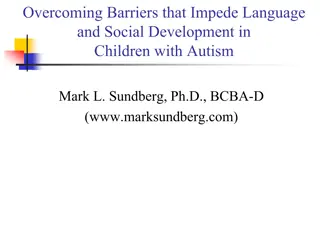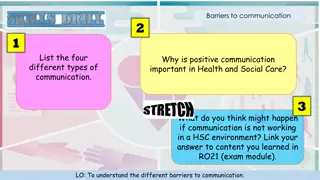Understanding Barriers to Communication in Health and Social Care
Explore the various barriers to effective communication in Health and Social Care settings, such as language differences, patronizing language, fatigue, body language, and more. Understand why it is crucial to address these barriers to ensure fair access to services and positive outcomes for service users. Identify ways to overcome these obstacles and learn how they can impact communication in different environments.
- Communication barriers
- Health and Social Care
- Overcoming obstacles
- Effective communication
- Access to services
Download Presentation

Please find below an Image/Link to download the presentation.
The content on the website is provided AS IS for your information and personal use only. It may not be sold, licensed, or shared on other websites without obtaining consent from the author. Download presentation by click this link. If you encounter any issues during the download, it is possible that the publisher has removed the file from their server.
E N D
Presentation Transcript
Barriers to communication 2 1 List the four different types of communication. Why is positive communication important in Health and Social Care? 3 What do you think might happen if communication is not working in a HSC environment? Link your answer to content you learned in RO21 (exam module). LO: To understand the different barriers to communication.
Task 2: Barriers to communication This is marked with Positive Factors in Task 1 and is worth 9 marks. Spelling, punctuation and grammar are also marked in this part. LO: To understand the different barriers to communication.
What are some barriers to communication? List as many as you can think of. Why is it important to consider potential barriers to communication? Health, Social Care and Early Years services are required to give everybody the right to fair access HOWEVER Barriers to communication may prevent some service users from easily accessing health, social care and early years services, so some services are not used by individuals who need them. LO: To understand the different barriers to communication.
What is a barrier? Something that prevents something happening or being able to use a service or setting. What are barriers to communication? Something that can affect the results of conversation. What are the barriers to communication? Language patronising language, difference in language spoken, inappropriate use of language Tiredness Inappropriate body language Aggression Inadequate space Furniture damaged or unsuitable Speech difficulties due to disabilities or illness Noise Poor lighting LO: To understand the different barriers to communication.
For each barrier discussed, you must: 1. 2. 3. 4. Name it Explain how it can affect/influence communication Explain how it can be overcome (reduced or gotten rid of) Give an example of how each barrier could affect communication in different settings. It is up to you how you present this information. A possible way would be a table/chart similar to the previous task. LO: To understand the different barriers to communication.
Language Think about all the positive factors influencing communication barriers could include the opposite to this. Patronising language: use of terms such as sweetie , dear and love may be interpreted as patronising by some individuals, as they may feel they are being treated as children and not adults. Not addressing individuals in the way they prefer can act as a barrier in getting to know and communicate with them. It is important not to talk down to people or belittle them. Adults may be offended or feel that they are not being respected. Children might not want to cooperate. LO: To understand the different barriers to communication.
Language How can you overcome patronising language? Staff need to be trained in active listening (thinking about what has been said and how you are going to respond). This will help them relate to clients and other staff in a good way and not make assumptions about them. 3 minutes Write an example now! LO: To understand the different barriers to communication.
Language Inappropriate use of language: different words should be used in communicating with children and adults e.g. it is fine to ask a 2-year-old if they want to have a wee but is inappropriate to use the same words when addressing the toileting needs of an 82-year-old. Other examples could include: Using words that the client does not understand Shouting at clients especially if they are ill, e.g. dementia can make the person feel scared Verbally abusing a client to make them feel scared or intimidated. LO: To understand the different barriers to communication.
Language How can you overcome inappropriate use of language? By using a calm tone and controlling emotions when talking to someone with a difficulty. By using words that the other person can understand. By being patient if being asked the same question over and over again. 3 minutes Write an example now! LO: To understand the different barriers to communication.
Language Difference in language spoken: not understanding the language being spoken can lead to misunderstandings and the messages sent not being understood. As a result communication and information will not be understood. How can this be overcome? Training staff: have staff who can speak different languages. Use an interpreter. Leaflets and information should be in other languages. Pictures can be used especially with children 3 minutes Write an example now! LO: To understand the different barriers to communication.
Task 2: Barriers to communication Use your assignment brief booklets to begin this task. Barriers to complete this lesson: Patronising language Inappropriate use of language Differences in language spoken. For each barrier: 1. Name it 2. Explain how it can affect/influence communication 3. Explain how it can be overcome (reduced or gotten rid of) 4. Give an example of how each barrier could affect communication in different settings. It is up to you how you present this information. A possible way would be a table/chart similar to the previous task. LO: To understand the different barriers to communication.
Responses and discussion. LO: To understand the different barriers to communication.
Barriers to communication 2 1 Describe one way in which language barriers can be overcome. Provide an example in your answer. List the barriers to communication that relate to language. P I D 3 What barriers to communication do you think an individual with a learning disability might have? What can be done to overcome them? LO: To understand the different barriers to communication.
Task 2: Barriers to communication This is marked with Positive Factors in Task 1 and is worth 9 marks. Spelling, punctuation and grammar are also marked in this part. LO: To understand the different barriers to communication.
Barriers to communication: Patronising language Tiredness Inappropriate body language Inappropriate use of language Aggression Difference in language spoken Speech difficulties due to illness Noisy environment Inadequate space Poor lighting Damaged or unsuitable furniture Task 2: Barriers to communication This is marked with Positive Factors in Task 1 and is worth 9 marks. Spelling, punctuation and grammar are also marked in this part. LO: To understand the different barriers to communication.
Tiredness Tiredness: being tired can lead to negative messages, both verbally and non-verbally, e.g. short, abrupt responses, mumbled speech, lack of eye contact, slumped shoulders. This may lead to individuals misinterpreting these signs as a lack of interest or willingness to communicate with them; it may in turn lead them to withdraw or become frustrated. How can this be overcome? Training staff. Try to understand why the person is tired (empathy). Staff should try not to make the person feel more tired. Avoid confrontations and arguments. If the person is tired a lot it should be looked into, e.g. are they ill? 3 minutes Write an example now! LO: To understand the different barriers to communication.
Aggression Aggression: being verbally and/or physically aggressive can prevent positive communications because people react to feeling unsafe either by retreating and refusing to communicate or by becoming aggressive themselves. It can lead to someone being hurt emotionally or physically. How can this be overcome? Training staff in how to deal with someone who is aggressive. Using a calm tone. Staff should try to find the cause of the aggression. Try to calm the other person down by using the right words and tone. Use open body language. Diverting attention of the aggressive person to something they like. 3 minutes Write an example now! LO: To understand the different barriers to communication.
Inappropriate body language Personal space if a staff member sits too close it might make them feel uncomfortable and not want to communicate. Closed body language e.g. arms folded, hands in pockets, no eye contact. It could show that they aren t interested and are unfriendly. How can this be overcome? Training staff in how in non-verbal communication. Make sure that there is an appropriate level of space. Use open body language to show that you are interested and friendly. E.g. maintain eye contact, smile, lean forwards etc. This can make the other person feel relaxed and more comfortable. 3 minutes Write an example now! LO: To understand the different barriers to communication.
Speech difficulties due to illness or disability Communication with people with additional needs or difficulties can make being understood difficult. E.g. - Dementia can affect an individual s speech and use of language; this is because it causes damage to the parts of the brain that control an individual s speech and language. How can this be overcome? Training staff to use special methods of communication, e.g. Braille, sign language, Makaton. Use of special equipment e.g. hearing aids. Use other people to speak for the person an advocate. 3 minutes Write an example now! LO: To understand the different barriers to communication.
Task 2: Barriers to communication Barriers completed this lesson: Tiredness Aggression Inappropriate body language Speech difficulties due to disability or illness. For each barrier: 1. Name it 2. Explain how it can affect/influence communication 3. Explain how it can be overcome (reduced or gotten rid of) 4. Give an example of how each barrier could affect communication in different settings. It is up to you how you present this information. A possible way would be a table/chart similar to the previous task. LO: To understand the different barriers to communication.
Responses and discussion. LO: To understand the different barriers to communication.
Barriers to communication 2 1 List the barriers to communication that we have covered so far. Which barrier do you think is the most important one that needs to be considered and overcome when communicating? Justify your answer. P I D T A I S 3 Explain why it is important to overcome barriers to communication. Link your answer to the exam module. LO: To understand the different barriers to communication.
Barriers to communication: Patronising language Tiredness Inappropriate body language Inappropriate use of language Aggression Difference in language spoken Speech difficulties due to illness Noisy environment Inadequate space Poor lighting Damaged or unsuitable furniture Task 2: Barriers to communication This is marked with Positive Factors in Task 1 and is worth 9 marks. Spelling, punctuation and grammar are also marked in this part. LO: To understand the different barriers to communication.
Noisy environment If there is too much noise people will not be able to hear what is being said. They might not hear important information or instructions and not understand what to do or what is happening. Concentration could be affected also. Noisy environments can be distracting, making it difficult to share information. This can lead to individuals feeling frustrated, and not feeling valued, respected or listened to. How can this be overcome? Adapt the environment find a more suitable space to communicate or turn off/minimize distractions. 3 minutes Write an example now! LO: To understand the different barriers to communication.
Inadequate space Environments that are very small and overcrowded, i.e. with people/furniture, or have a lack of space to be able to move around comfortably, are unsuitable. Can lead to invasion of personal space. It can make people feel uncomfortable and lose concentration. How can this be overcome? Adapt the environment remove any unnecessary items from the room. Find a quiet room if there are too many other people around. Furniture could be rearranged or removed to make space. 3 minutes Write an example now! LO: To understand the different barriers to communication.
Poor lighting Can stop people seeing facial expressions, body language etc. This could lead to misunderstandings. If sign language or lip reading is being used the person might not be able to see it and not understand. Bright lights can make the person feel that they are being intimidated. How can this be overcome? Adapt the environment Turn on some lights or open the blinds/curtains if the room is too dark. Lighting should be suitable for what is happening. If instructions are being given the lighting should be bright so that the person can see. If someone is upset lighting should be softer to encourage them to talk. 3 minutes Write an example now! LO: To understand the different barriers to communication.
Damaged or unsuitable furniture Furniture needs to be comfortable and safe. If a person is talking to a child they should not be on a higher chair as the child could feel intimidated they would not feel relaxed or want to join in. Damaged furniture can lead to negative messages about the environment i.e. that it is unsafe and therefore not suitable for communication. Unsuitable furniture e.g. very large tables, uncomfortable chairs, can create barriers. How can this be overcome? Adapt the environment how could you do this? 3 minutes Write an example now! LO: To understand the different barriers to communication.
Task 2: Barriers to communication Barriers completed this lesson: Noisy environment Inadequate space Poor lighting Damaged or unsuitable furniture. For each barrier: 1. Name it 2. Explain how it can affect/influence communication 3. Explain how it can be overcome (reduced or gotten rid of) 4. Give an example of how each barrier could affect communication in different settings. It is up to you how you present this information. A possible way would be a table/chart similar to the previous task. LO: To understand the different barriers to communication.
Responses and discussion. LO: To understand the different barriers to communication.
Task 2: Barriers to communication Barriers to communication: Patronising language Tiredness Inappropriate body language Inappropriate use of language For each barrier: 1. Name it 2. Explain how it can affect/influence communication 3. Explain how it can be overcome (reduced or gotten rid of) 4. Give an example of how each barrier could affect communication in different settings. Aggression Difference in language spoken Speech difficulties due to illness Noisy environment Inadequate space Poor lighting Damaged or unsuitable furniture It is up to you how you present this information. A possible way would be a table/chart similar to the previous task. LO: To understand the different barriers to communication.























